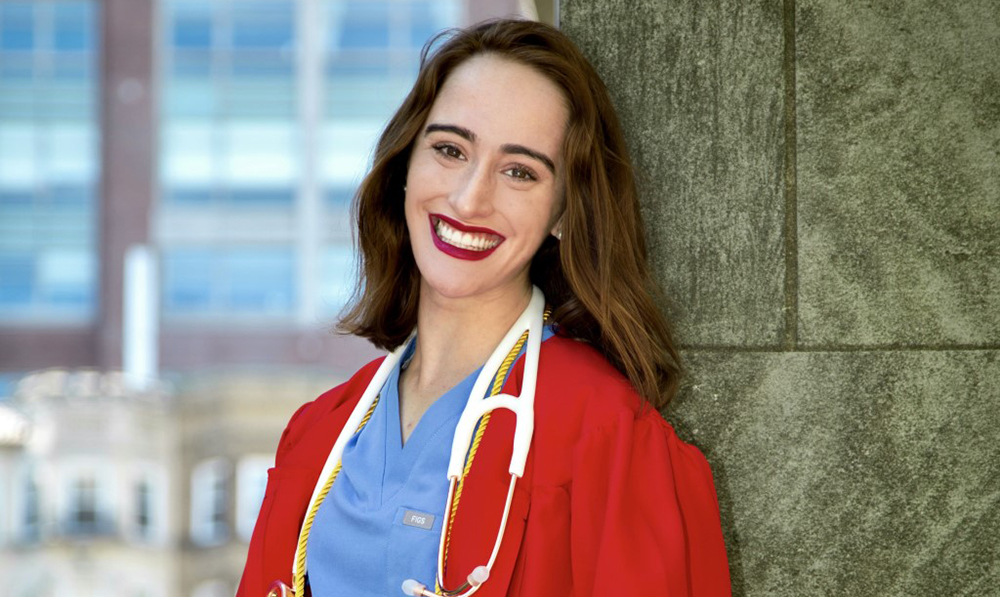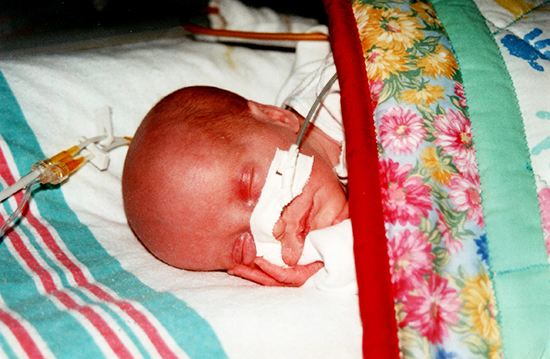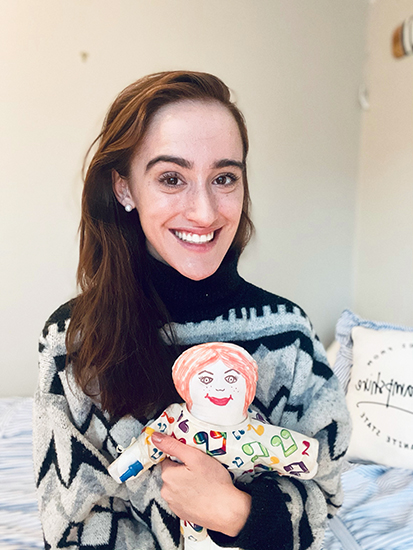Patient StoryMay | 11 | 2021
Lena's story: Personal experience inspires preemie to pursue a career in medicine


A year before she put on her college graduation cap, Lena Papadakis, 22, donned a surgical cap and followed Daniel Ryan, MD, into the operating room at MassGeneral for Children (MGfC). Except this time, she wasn’t a patient – she was a student, shadowing her childhood surgeon. Papadakis’s experience as a patient at MGfC inspired her to pursue a career in medicine and now, she was learning from Ryan, who has known her since the day she was born.

Papadakis, of North Hampton, NH, was born a triplet with her two sisters, one of which is her identical twin. All three were born premature at 32 weeks. At birth, Papadakis’s sisters weighed about 3 lbs. while she weighed just 2 lbs. While her sisters went home a few days after birth, Papadakis stayed in the Neonatal Intensive Care Unit (NICU) at MGfC for three months.
During her pregnancy, Papadakis’s mother learned two of her daughters had developed twin-to-twin transfusion syndrome (TTTS), a condition in which identical twins share uneven amounts of placenta. This affects how each twin grows and develops. Papadakis began to show signs of fetal distress, which prompted the triplets’ early delivery.
Once in the NICU, doctors discovered that she had developed abnormalities in her gastrointestinal (GI) and respiratory tracts, including a tracheoesophageal fistula, or an abnormal connection between the esophagus and the trachea (windpipe), and esophageal atresia, a condition in which the esophagus does not develop properly. Papadakis also had a laryngeal cleft, a rare connection between the larynx (voice box) and esophagus, tracheal stenosis, or narrowing of the trachea, and pyloric stenosis, in which the muscle that connects the stomach to the duodenum does not open and close properly. These conditions affected her breathing, growth and ability to eat and swallow.
Throughout her childhood, the hospital became a home away from home. Papadakis was admitted to the hospital multiple times. During the first four years of her life, she could develop up to 32 cases of pneumonia per year – about one case every two weeks. After numerous surgical repairs by age 4, she developed just 1-3 cases of pneumonia per year. This year marks her first year as pneumonia free.

“One of the many things I’m grateful for is that I was never afraid of the hospital because when you’re in the hospital, it’s okay to be sick,” said Papadakis, who studied on the pre-med track at Boston University (BU). “My experience growing up in a hospital environment and being around the best and the brightest from a young age is what inspired me to go into medicine.” She also recently won a senior award for her leadership in the field, something she attributes to her childhood spent surrounded by a team of problem solvers.
When caring for children with complex medical issues, like Papadakis, a team-based approach offers many advantages. “It allows us to look at everything from a different angle and with different philosophies,” said Ryan, a pediatric surgeon at MGfC who completed most of Papadakis’s surgical repairs. “As a surgeon, I can provide insight on anatomy whereas a pulmonologist, for example, would bring a completely different point of view. It’s that broad-based team that provides exceptional care for children and their families.”
On the inpatient floors, children receive care from a primary nurse who cares for them every time they stay at the hospital. This allows for stronger relationships with care team members and higher quality care. During her stays on Ellison 17, Lena and her family developed a close relationship with her primary nurse, Elise Drew, RN.
“Her family looked to me for guidance and support. They were very worried, and they put their absolute trust in my hands,” said Drew. “I explained everything to them and involved Child Life Services whenever they were needed. I did my best to reassure Lena and her family and keep them safe.”
In May 2021, Papadakis graduated at the top of her class at BU. She plans to attend medical school in the next year or two.
“I’ve always felt pulled to work in pediatrics and I think my own experience plays a role in that,” said Papadakis. “There’s a certain magic touch in pediatrics that you don’t find anywhere else. Because of the care I’ve received, I learned to thrive and pursue my dreams regardless of a diagnosis. I want to help other children realize that too because that’s what was encouraged in me.”
Papadakis still receives care at MGfC, and her sense of determination has only grown over the years. “With Lena, she is very goal-driven – always. She is driven to succeed, whether it’s to meet her own goals or goals that we discussed as a team,” said Bernard Kinane, MD, chief of Pediatric Pulmonary Medicine at MGfC and member of Papadakis’s care team. “Lena is resilient and tough, in a good way, and strong. She is an impressive young lady for sure.”
Back in the operating room, Papadakis and Ryan prepare for a full day of mentorship – a privilege both of them treasure. “Lena was very small and fragile when she was born and now that she’s grown up, she represents the outcomes that we, as medical providers, are always aiming for,” said Ryan. “It takes a lot of work to do that. It’s a sign of how special she is.”
Graduation photo courtesy of Savya Virmani.
Featured Providers
-
![]()
- Chief, Pediatric Pulmonary Unit
- Associate Chief for Education
- Director of Pediatric Sleep Program and Pediatric Cardiopulmonary Exercise Laboratory
-
![]()
- Visiting Surgeon, Massachusetts General Hospital
Related Pages
Type
Appointments and Referrals
Request an appointment or second opinion, refer a patient, find a doctor or view test results with MGfC's secure online services.



